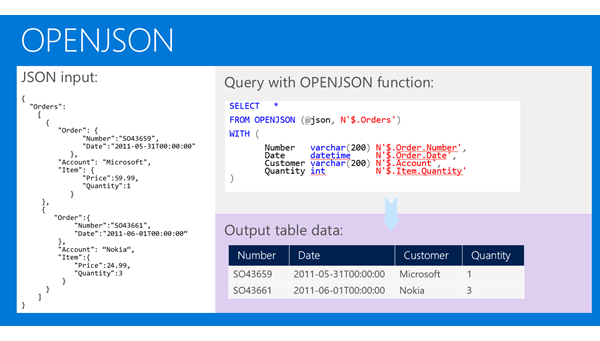JSON in SQL Server 2016
JSON functions in SQL Server enable you to analyze and query JSON data, transform JSON to relational format, and export SQL query results as JSON text.

If you have JSON text, you can extract data from JSON or verify that JSON is properly formatted using built-in functions JSON_VALUE, JSON_QUERY, and ISJSON. For more advanced querying and analysis, the OPENJSON function can transform an array of JSON objects into a set of rows. Any SQL query can be executed on the returned result set. Finally, there is the FOR JSON clause that enables you to format query results as JSON text.
SELECT TOP 1000 [Version]
,[OSType]
,[Online]
,[OnlineT]
FROM [ApplicationTest].[dbo].[table1]
for json auto
We can start with simple examples. In the following Transact-SQL code, we will define a text variable where we will put JSON text:
DECLARE @json NVARCHAR(4000)
SET @json =
N'{
"info":{
"type":1, "address":{
"town":"Bristol",
"county":"Avon",
"country":"England"
},
"tags":["Sport", "Water polo"]
},
"type":"Basic"
}'
Now, we can extract values and objects from JSON text using the JSON_VALUE and JSON_QUERY functions:
SELECT
JSON_VALUE(@json, '$.type') as type,
JSON_VALUE(@json, '$.info.address.town') as town,
JSON_QUERY(@json, '$.info.tags') as tags
This query will return “Basic”, “Bristol”, and ["Sport", "Water polo"] values. The JSON_VALUE function returns one scalar value from JSON text (e.g. strings, numbers, true/false) that is placed on a JSON path specified as the second parameter. JSON_QUERY returns an object or array (in this example an array of tags) on the JSON path. JSON built-in functions use JavaScript-like syntax to reference values and objects in JSON text via second parameter.
The OPENJSON function enables you to reference some array in JSON text and return elements from that array:
SELECT value
FROM OPENJSON(@json, '$.info.tags') INSERT INTO Orders(Number, Date, Customer, Quantity)
SELECT Number, Date, Customer, Quantity
OPENJSON (@orders)
WITH (
Number varchar(200),
Date datetime,
Customer varchar(200),
Quantity int
) AS OrdersArray
Four columns in the result set that is returned by OPENJSON are defined in the WITH clause. OPENJSON will try to find the properties Number, Date, Customer, and Quantity in each JSON object and convert their values into columns in the result set. By default, NULL will be returned if the property is not found. The assumption in the query above is that the @orders variable contains the following JSON array:
'[
{"Number":1, "Date": "8/10/2012", "Customer": "Adventure works", "Quantity": 1200},
{"Number":4, "Date": "5/11/2012", "Customer": "Adventure works", "Quantity": 100},
{"Number":6, "Date": "1/3/2012", "Customer": "Adventure works", "Quantity": 250},
{"Number":8, "Date": "12/7/2012", "Customer": "Adventure works", "Quantity": 2200}
]'
As you can see, the transformation from a JSON text to a relational form is simple. You just need to specify column names and types and OPENJSON will find properties in JSON that match these columns. In this example, plain JSON is used; however, OPENJSON can handle any nested/hierarchical structure of JSON objects.
Also, OPENJSON can be used to combine relational and JSON data in the same query. If we assume that the JSON array shown in the previous example is stored in the Orders column, the following query can combine the columns and JSON fields:
SELECT Id, FirstName, LastName, Number, Date, Customer, Quantity
FROM Person
CROSS APPLY OPENJSON (OrdersJson)
WITH (
Number varchar(200),
Date datetime,
Customer varchar(200),
Quantity int ) AS OrdersArray


select * from [dbo].[table1] for json auto declare @jsondata varchar(max)
set @jsondata=N'[{"Version":"2.1.1.1","OSType":1,"Online":1,"OnlineT":"on"},{"Version":"2.1.1.2","OSType":1,"Online":1,"OnlineT":"on"}]'; select Version
from openjson(@jsondata)
with(
Version varchar(50)
)
JSON in SQL Server 2016的更多相关文章
- SQL Server 2016原生支持JSON
转载原地址: http://www.cnblogs.com/lyhabc/p/4747694.html SQL Server 2005 开始支持 XML 数据类型,提供原生的 XML数据类型.XML ...
- SQL Server 2016新特性: 对JSON的支持
SQL Server 2005开始支持XML数据类型,提供原生的XML数据类型.XML索引及各种管理或输出XML格式的函数.随着JSON的流行,SQL Server2016开始支持JSON数据类 ...
- 微软发布正式版SQL Server 2016
微软于今天在SQL 官方博客上宣布 SQL Server 数据库软件的正式发布版本(GA),历时一年多,微软为该软件发布了多个公共预览版和候选版本,而今天最终版本终于上线了.在博客中,微软数据集团的企 ...
- SQL Server 2016 CTP2.2 的关键特性
SQL Server 2016 CTP2.2 的关键特性 正如微软CEO 说的,SQL Server2016 是一个Breakthrough Flagship Database(突破性的旗舰级数据库 ...
- 数据库技术丛书:SQL Server 2016 从入门到实战(视频教学版) PDF
1:书籍下载方式: SQL Server2016从入门到实战 PDF 下载 链接:https://pan.baidu.com/s/1sWZjdud4RosPyg8sUBaqsQ 密码:8z7w 学习 ...
- SQL Server 2016最值得关注的10大新特性
全程加密技术(Always Encrypted) 全程加密技术(Always Encrypted)支持在SQL Server中保持数据加密,只有调用SQL Server的应用才能访问加密数据.该功能支 ...
- SQL Server 2016 特性和安装方法
SQL Server 2016 特性: 全程加密技术(Always Encrypted),动态数据屏蔽(Dynamic Data Masking),JSON支持,多TempDB数据库文件,PolyBa ...
- SQL Server 2016 ->> T-SQL新特性
1) TRUNCATE表分区而不是整表 CREATE TABLE dbo.TruncatePartitionTest ( PrtCol INT, Col2 ) ) ON [myPS1](PrtCol) ...
- SQL Server 2016白皮书
随着SQL Server 2016正式版发布日临近,相关主要特性通过以下预览学习: Introducing Microsoft SQL Server 2016 e-bookSQL Server 201 ...
随机推荐
- centos7 开放3306端口并可以远程访问
开启远程访问: GRANT ALL PRIVILEGES ON *.* TO 'root'@'%' IDENTIFIED BY 'root' WITH GRANT OPTION; 允许任何ip以roo ...
- 在.NET中调用Java的类
.NET不能直接调用Java的类,但IKVM.NET解决了这个问题. IKVM.NET提供了两种方式调用java的类: ①把生成的jar包放置在程序根目录,然后通过创建URL实例的方式去调用类中的方法 ...
- 【重磅干货整理】机器学习(Machine Learning)与深度学习(Deep Learning)资料汇总
[重磅干货整理]机器学习(Machine Learning)与深度学习(Deep Learning)资料汇总 .
- Python全栈开发之路 【第五篇】:Python基础之函数进阶(装饰器、生成器&迭代器)
本节内容 一.名称空间 又名name space,就是存放名字的地方.举例说明,若变量x=1,1存放于内存中,那名字x存放在哪里呢?名称空间正是存放名字x与1绑定关系的地方. 名称空间共3种,分别如下 ...
- 腾讯内推一面C++
北邮论坛找个腾讯的内推,没想到那么快就安排面试了.第一次面腾讯,写点东西记录一下吧. 面的是位置服务部门. 去了之后HR先给了两张纸,有三道编程题.第一道是求 二进制中1的个数(考察位运算)(剑指of ...
- python中变量、函数、类名、模块名等命名方式
摘要:模块名:小写字母,单词之间用_分割ad_stats.py包名:和模块名一样类名:单词首字母大写AdStatsConfigUtil全局变量名(类变量,在java中相当于static变量):大写字母 ...
- html总结:表格中的文字居中
<style> table { text-align:center; } </style>
- Linux watchdog
使用 watchdog 构建高可用性的 Linux 系统及应用https://www.ibm.com/developerworks/cn/linux/l-cn-watchdog/index.html ...
- CentOS的el5, el6, el7代表什么
https://www.cnblogs.com/EasonJim/p/9051851.html el: enterprise linux?
- PyCharm3.0默认快捷键
PyCharm3.0默认快捷键(翻译的) 1.编辑(Editing) Ctrl + Space 基本的代码完成(类.方法.属性) Ctrl + Alt + Space 快速导入任意类 Ctrl + S ...
